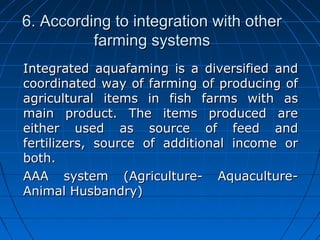Basics of aquaculture – definition
- 1. BASICS OF AQUACULTURE – DefinitionBASICS OF AQUACULTURE – Definition and scopeand scope Aquaculture is the farming of aquaticAquaculture is the farming of aquatic organisms including fish, mollusks,organisms including fish, mollusks, crustaceans and aquatic plants.crustaceans and aquatic plants. Farming implies some form ofFarming implies some form of intervention in the rearing process tointervention in the rearing process to enhance production, such as regularenhance production, such as regular stocking, feeding, protection fromstocking, feeding, protection from predators, etc.. Farming also impliespredators, etc.. Farming also implies individual or corporate ownership of theindividual or corporate ownership of the stock being cultivated. ( As per FAO)stock being cultivated. ( As per FAO)
- 2. Thus aquaculture is underwaterThus aquaculture is underwater agriculture or aquafarming. Moreagriculture or aquafarming. More simply Aquafarming is propagationsimply Aquafarming is propagation of aquatic organisms in controlled,of aquatic organisms in controlled, semi controlled or simulatedsemi controlled or simulated conditions.conditions.
- 3. Indian FisheriesIndian Fisheries Global positionGlobal position 33rdrd in Fisheriesin Fisheries 22ndnd in Aquaculturein Aquaculture Contribution of fisheries to GDPContribution of fisheries to GDP (%)(%) 1.071.07 (Rs. 34,758 crore)(Rs. 34,758 crore) Contribution to agricultural GDPContribution to agricultural GDP (%)(%) 5.845.84 Per capita fish availability (kg)Per capita fish availability (kg) 9.09.0 Annual export earningsAnnual export earnings (Rs. in crore)(Rs. in crore) 7,2007,200 Employment in sector (million)Employment in sector (million) 14.014.0
- 4. Aquatic ResourcesAquatic Resources CoastlineCoastline 8118 kms8118 kms Exclusive economic zoneExclusive economic zone 2.02 million sq. km2.02 million sq. km Rivers and canalsRivers and canals 1,97,024 km1,97,024 km ReservoirsReservoirs 3.15 million ha3.15 million ha Ponds and tanksPonds and tanks 2.35 million ha2.35 million ha Oxbow lakes and derelictOxbow lakes and derelict waterswaters 1.3 million ha1.3 million ha Brackish waterBrackish water 1.24 million ha1.24 million ha EstuariesEstuaries 0.29 million ha0.29 million ha
- 5. Fish factsFish facts Present fish productionPresent fish production 6.57 mt6.57 mt Marine: 2.82Marine: 2.82 Inland: 3.75Inland: 3.75 Production potentialProduction potential 8.4 mt8.4 mt Marine: 3.90Marine: 3.90 Inland: 4.5Inland: 4.5 Fish seed productionFish seed production 22615 million fry22615 million fry HatcheriesHatcheries 1,0701,070 FFDAFFDA 429429 BFDABFDA 3939
- 6. Purpose of AquaculturePurpose of Aquaculture Utilization of available natural water resourcesUtilization of available natural water resources To increase production for per capita consumptionTo increase production for per capita consumption and incomeand income Ornamental purposeOrnamental purpose Sports and game purpose.Sports and game purpose. Upliftment of socioeconomic status of peopleUpliftment of socioeconomic status of people Create employment opportunities.Create employment opportunities. Utilization of byproducts like fish, liver oil, fishUtilization of byproducts like fish, liver oil, fish protein concentrate, etc.protein concentrate, etc.
- 7. Advantages of fin fish cultureAdvantages of fin fish culture Poikilothermic or cold blooded animal,Poikilothermic or cold blooded animal, so need not spend energy forso need not spend energy for temperature regulation of body.temperature regulation of body. Specific gravity of fish is about 1.02-Specific gravity of fish is about 1.02- 1.06 which is nearly same with that of1.06 which is nearly same with that of water, so need not spend energy forwater, so need not spend energy for maintaining its position in water.maintaining its position in water. Fish do not consume water.Fish do not consume water.
- 8. Higher fecundity.Higher fecundity. Edible tissues of fish (80.9%) isEdible tissues of fish (80.9%) is greater than chicken broiler (64.7)greater than chicken broiler (64.7) Convert food to body tissues moreConvert food to body tissues more efficiently than any other farmefficiently than any other farm animal.animal.
- 9. Different types of AquacultureDifferent types of Aquaculture 1. According water system1. According water system -Static culture system-Static culture system -Flowing culture system-Flowing culture system -Semi - closed recirculating system.-Semi - closed recirculating system. 2. According to type of water2. According to type of water -coldwater fish culture-coldwater fish culture -Warm water fish culture-Warm water fish culture -Freshwater fish culture-Freshwater fish culture -Mariculture-Mariculture -brackish water culture-brackish water culture
- 10. 3. According to stocking combination3. According to stocking combination -Monoculture-Monoculture -Polyculture (Composite)-Polyculture (Composite) 4. According to intensity of efforts4. According to intensity of efforts -subsistence fish culture-subsistence fish culture -extensive fish culture-extensive fish culture -semi intensive fish culture-semi intensive fish culture -intensive fish culture-intensive fish culture -super intensive fish culture-super intensive fish culture
- 11. 5. According to cultured group5. According to cultured group -fin fish culture-fin fish culture -shell fish culture-shell fish culture -frog culture-frog culture -seaweed culture-seaweed culture -fresh water plant culture.-fresh water plant culture.
- 12. 6. According to integration with other6. According to integration with other farming systemsfarming systems Integrated aquafaming is a diversified andIntegrated aquafaming is a diversified and coordinated way of farming of producing ofcoordinated way of farming of producing of agricultural items in fish farms with asagricultural items in fish farms with as main product. The items produced aremain product. The items produced are either used as source of feed andeither used as source of feed and fertilizers, source of additional income orfertilizers, source of additional income or both.both. AAA system (Agriculture- Aquaculture-AAA system (Agriculture- Aquaculture- Animal Husbandry)Animal Husbandry)
- 13. 7. Special culture system7. Special culture system • Cage cultureCage culture • Pen culturePen culture • Sewage fed fish cultureSewage fed fish culture • String culture.String culture.












